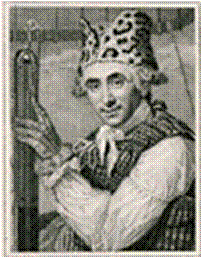National Weatherperson's Day (February 5th)
February 5th is National Weatherman's Day, commemorating the birth of John Jeffries in 1744. Jeffries, a Boston physician and one of America's first weather observers, began taking daily weather observations in Boston in 1774. He took the first balloon weather observation over London in 1784. He carried a thermometer, a barometer, and a hygrometer to the height of 9000 feet. This is a day to recognize the men and women who collectively provide Americans with the best weather, water, and climate forecasts and warning services of any nation.

Photo of John Jeffries
Many of us take weather information for granted. Turn on a light switch, you get light. Turn on your television or radio, or check a web site and you get the weather forecast. It’s easy to forget that around the clock, dedicated meteorologists and weathercasters are vigilantly creating forecasts to help you plan your day, and issuing warnings to help keep you safe.
Photo of the NWS Wichita
The men and women at your local National Weather Service (NWS) forecast office gather the raw weather data, analyze the data, and study numerical computer models in order to issue the weather and river forecasts and warnings to protect life and property. Specialized marine and aviation forecasts help enhance the Nation’s economy. Spot forecasts help firefighters control wildfires and emergency management officials contain hazardous chemical spills. Extensive climate records help engineers, architects, researchers, insurance companies and utilities.
Locally, your NWS Wichita forecast office serves 26 counties across Central, South Central and Southeastern Kansas. The NWS Wichita office has a total of 18 meteorologists on staff with at least a bachelors degree in Meteorology or Atmospheric Sciences. Our meteorologists work around the clock, 365 days a year, constantly monitoring local weather conditions. There is a total of 24 people staffed at our office, including an Administrative Assistant, an Information Technologist (IT), a Service Hydrologist and 3 electronics personnel who all keep our office and equipment running, especially in times of severe weather.
But the NWS couldn't accomplish its mission without a diverse group of partners helping in the process.
Nationwide, more than 11,000 volunteer Cooperative Observers take regular measurements of temperature, precipitation and other data, which is used by forecasters and climatologists. Nearly 300,000 volunteer storm spotters are trained by the NWS to provide visual reports of severe weather conditions to forecast offices and local emergency management officials. Volunteer amateur radio operators provide critical emergency communications during severe weather.
The NWS Wichtia office has a network of 105 dedicated volunteer Cooperative Observers throughout Central, South Central and Southeastern Kansas. In addition to the official COOP network, several hundred volunteer observers are now reporting rain and snow measurements through the new Community Collaborative Rain, Hail, and Snow (CoCoRaHS) network across our region. Many more people are part of a citizens weather observation program who allow weather data from their home weather stations to be transmitted over the internet and used by meteorologists to help make timely forecasts and issue life saving warnings. Between 2000 and 3000 people attend Skywarn severe storm spotter training classes in the local area each year and act as the eyes and ears for NWS warning meteorologists.
Most of the colorful weather graphics seen on television and in newspapers come from another member of the America's weather team. Commercial weather companies enhance the presentation of the NWS data and information for their clients in the media and in many weather-sensitive industries, and provide customized forecasts and services for clients.
And finally, television weathercasters are the most visible members of the America's weather team. They are the trusted faces many people turn to for weather information, and they relay the NWS’s official watches and warnings for hazardous weather to help keep you safe.
On National Weatherman's Day, the NWS would like to thank all of the volunteers and our partners in television and commercial weather services. Thank you!